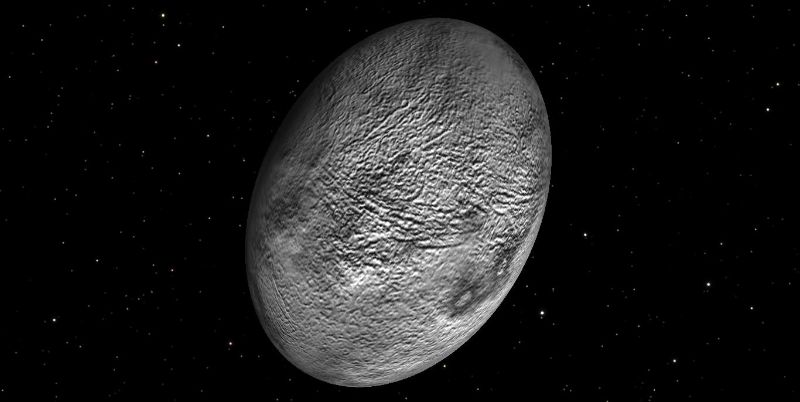The conception of the Solar System changed completely when small planets were discovered beyond Pluto. One of them, is the popular and characteristic dwarf planet named Haumea, clear example of the extension of the universe. Haumea is part of a select group of dwarf planets of interest, so it has far-reaching scientific relevance.
Haumea is also known for being cataloged among the most outstanding trans-Neptunian objects. Similarly, it has its domicile immersed in the fantastic Kuiper belt beyond Pluto. In general terms, it is a particular planet, with a rapid rotation and a flattened shape. There is no doubt that it is an interesting object in the confines of the Solar System.
You may also be interested in our article:When did the discovery of the planets begin? What was the first?
Revealing all that surrounds Haumea. Why is this particular dwarf planet of such scientific interest?
Within the category of dwarf planets, Pluto was the one that stood out the most until the discovery of the rest. It was at this time that Haumea began to appear on the map as another renowned planetoid.
Named that way by the MPC (Minor Planets Center in Spanish), it was discovered on March 7, 2003. From that moment on, it was cataloged in different categories to be distinguished scientifically. These are nothing more and nothing less than trans-Neptunian objects, dwarf planet and plutoid.

Source: Google
Once it was discovered studies began on its structure and conformation. Today, Haumea is known to have a specific flat or scientifically named ellipsoidal shape.
This conclusion is due to the constant observation of its light, where it was concluded that it has a curvature. In that sense, its major axis is longer compared to its opposite, the minor axis of the planet.
Regarding its general characteristics, Its density is barely a third that of Pluto. if it is compared. For its part, the surface has a unique quality: it is complete, almost entirely, by ice.
Likewise, Haumea is considered one of the planetoids that radiate the most amount of light when observed. One of its zones is even differentiated thanks to this peculiarity as a dense red area, similar to a large spot.
Uniquely, Haumea is a planetoid with a highly distinguishable feature among the rest. Its structure is made up of a ring of rocks and, around it, two moons orbit like a satellite.
Haumea, a dwarf planet discovered nearly two decades ago. How was it possible to locate it?
The discovery of Haumea, a dwarf planet beyond Pluto, was mired in controversy for a while. To determine its existence, a few events occurred that marked the way to what is known today.
The protagonists of these events were two teams from locations separated by kilometers. The first, from Spain, made up of Pablo Santos Sanz and José Luis Ortiz, from the Institute of Astrophysics of Andalusia.
On the other side of the world, was the second team made up of Mike Brown and Chad Trujillo respectively. They were natives at that time of the CALTECH, competing for Haumea's patent.
The particularity associated with this discovery and which is similar in both cases, is that the teams used images precautionary to see the planet. However, the team led by Santos Sanz and Ortiz identified the planet from March 7 to 10, 2003. The second team would confirm the results a year later, in December 2004.
This is how the birth of Haumea, a dwarf planet with characteristics similar to Pluto, arose. It was at that time that the premise of validating the presence of trans-Neptunian objects and increasing the importance of the Kuiper belt was contributed.
However, the controversy arose because Brown's team, He preferred to wait to know more about the find. Question that the European faction led by Santos Sanz y Ortiz, did not take into consideration.
After presenting their findings to the MPC, a virtually tentative name was given to the new planet. In July 2005, it was declared as Haumea, the tenth planet of the Solar System respectively.
The planet Haumea and everything that is known about it. How is it exactly?

Source: Google
The planet Haumea was one of the great discoveries of the time. Basically, it served to reinforce the theory that beyond Neptune and Pluto, there were still celestial objects to know.
In general, Haumea is one of the five most important dwarf planets in the Solar System. According to this particularity, it ranks fifth in that classification, behind Pluto, Eris, Ceres and Makemake.
Most of the scientific community has had problems to reach a consensus on the properties of the planet Haumea. However, what has been concluded is that it is a rocky, terrestrial planet with a large amount of ice on its surface.
Composition and shape
The planet Haumea is recognized for its particular shape, secondary to a large impact with another larger object. As a result, its ellipsoidal or 3D ellipse appearance has gained popularity and interest from the scientific community.
As for its composition, Haumea is known to be covered by a thin layer of ice. Beneath it, lies a rocky layer of different materials that, until now, have yet to be revealed.
Haumea's surface
Calculating Haumea's surface albedo not only helped determine how accurately it measures. Also, it served to clarify more about its particular surface in general. The same, as already mentioned, is endowed with an extensive layer of ice capable of reflecting a large percentage of radiation.
Ring, moons and other peculiarities
haumea it is known to possess a rocky ring around its conformation. In turn, it is one of the dwarf planets with natural satellites, being Hi'iaka and Namaka respectively. For its part, among other interesting features about Haumea, is the length of its day, just over 4 hours as such.